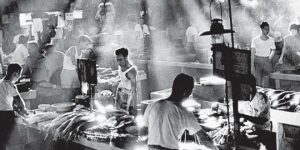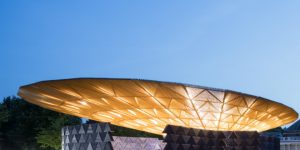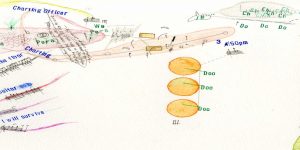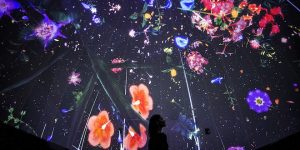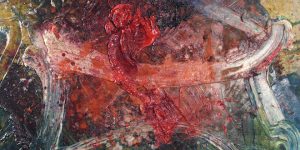Exhibition at MOCA, Taipei: ‘Spectrosynthesis’
A look at ‘Spectrosynthesis’, an exhibition championing LGBTQ rights

Haiyang Wang, ‘Wall Dust’, 2013-16. Image courtesy White Space Beijing
The story goes that there is a pot of gold to be found at the end of the rainbow.
‘Spectrosynthesis – Asian LGBTQ Issues and Art Now’ which will take place at MOCA Taipei from 9 September to 5 November is the first exhibition exploring issues the LGBTQ community faces in a government-run Asian art museum. The title combines the words “spectrum”, referring to the rainbow as a recognized symbol for the diverse community, and “photosynthesis” for light as a source of energy for all living things. Co-hosted by Sunpride Foundation, which promotes equality for all human beings, including the LGBTQ community, it makes a bold statement both about how far society has come and how much further it still has to go to secure equal rights for everyone.
Sunpride Foundation was founded in 2014 to support artistic practice, and promote equal rights for LGBTQ (Lesbian, Gay, Bisexual, Transgender, Queer/Questioning) individuals. Patrick Sun, Executive Director of Sunpride Foundation highlights the role of art in championing this cause, saying, “The foundation aims to foster a stronger, healthier and more equitable world for LGBTQ people and their allies; and to encourage and inspire a generation of young artists to take action and create positive changes to the LGBTQ experience by exhibiting and preserving art that speaks to the society at large.” The Foundation has established a collection of Asian art created by artists in the LGBTQ community or works with a focus on LGBTQ theme.

Martin Wong, ‘Ferocactus Peninsulae V. Viscainensis’, 1997-8. Image courtesy The Martin Wong Estate and P.P.O.W Gallery
Taiwan was a natural choice for Sunpride Foundation’s inaugural exhibition. Sun says, “Taiwan’s LGBTQ equal right movement is the most progressive in Asia, and that explains why it was our natural and ideal choice to launch this exhibition.” On 24 May 2017, Taiwan’s top court had ruled that bans on same-sex marriages were unconstitutional, paving the way for new laws in the country to protect same-sex couples who chose to tie the knot, and affording them the same rights as heterosexual married couples. Sun adds, “MOCA was also our first choice to present this exhibition because of its philosophy to embrace the spirit of innovation and challenging new issues.”
‘Spectrosynthesis’ presents artworks by 22 ethnic Chinese artists from Taiwan, China, Hong Kong and Singapore, and also includes works by one Chinese Canadian and two Chinese American artists. The final selection has been years in the making. From an initial list of 60 potential artists for the exhibition, Sean Hu, curator of the exhibition, together with the rest of the curatorial team, conducted field research, went on studio visits, and collected data and oral accounts. Speaking about the exhibition in its final form, Hu says, “It is dedicated to addressing the historical, cultural and political development of the ethnic-Chinese LGBTQ community, as well as the dilemma they face in the contemporary world.”

Shiy De-Jinn, ‘Young Girl’, 1960. Image courtesy Sunpride Foundation
The artworks in the exhibition address the wide range of subject matters that the LGBTQ community faces, such as identity, equality, social oppression, discrimination and stigmatisation. Desire is a theme that stands out in the complex labyrinth of issues that its members face every day. Hu says, “In this exhibition, audience will be able to see “the conversation” created by artists in different times and places that expresses the pursuit and symbolism of desire.”
To present the struggles of LGBTQ artists, the artworks selected for the exhibition occupy a long timeline to reflect the changing times and conditions in which they have lived and worked, where some things change and others remain the same. A painting of a young girl sitting alone on a chair by late Taiwanese artist Shiy De-Jinn, who created many representative portraits from the 60s, depicts the loneliness and yearning he felt at a time when he had to suppress his feelings. A work by another late artist, Chinese-American Martin Wong, of a thorny barrel cactus, alludes to the defense mechanisms LGBTQ individuals have to adopt to live their lives among people unaccepting of their true selves.
The disappointment and isolation that LGBTQ individuals face continue to be depicted in a more recent video work, ‘Life and Death in Venice’, made by Singapore artist Ming Wong after the Italian cinematic classic, ‘Death in Venice’, which evokes the universal feeling of desire, and as in the case of many of the works in the show, the anguish of unrequited desire.

Ming Wong, ‘The Life and Death in Venice’, 2010. Image courtesy the artist
Another highlight in the exhibition is ‘Muted Situation #5: Muted Chorus’, a single-channel HD video work by Hong Kong sound artist Samson Young, which extends the narrative that LGBTQ individuals’ desires are unmet, silenced or suppressed. In this work featuring a choral composition, everything but the expected musical performance is heard. Instead, the audience hears the breathing of the singers and other sounds made from the movement of their bodies, the flipping of musical scores and so on, drawing attention to sounds that people do not necessarily want to hear.
The exhibition as a whole is both marking of the progress made in society’s acceptance of the LGBTQ community and an attempt to change more hearts and minds to the notion that its individuals are like everyone else, with hopes, dreams and fears. Earlier in the year, Tate Britain had opened the show ‘Queer British Art, 1861-1967’ to mark the 5oth anniversary of the 1967 Sexual Offences Act, which decriminalised private homosexual acts between men over 21 in England and Wales. ‘Spectrosynthesis’ is a similar endeavour in Asia, opening up possibilities for frank conversation about and with members of society that remain marginalised by the general population.
Sunpride Foundation aims to enact real change in Asia through art, which it believes is an effective medium of communication to convey its message. Sun says, “Presently our collection focuses on Asian art, where we feel the Foundation could make the best effort in accomplishing its mission. Art is a universal language, and it’s very important to Sunpride,” says Sun. “We are committed to support artistic practice and promote equal rights for LGBTQ individuals through meticulous research and discourse on contemporary art.”
‘Spectrosynthesis’ champions LGBTQ individuals by giving them a voice, and encouraging conversation about the rights that they deserve. “We hope the exhibition will create a rippling effect on other Asian societies in terms of values, ideas and thoughts regarding the issues of gender diversity,” says Hu. “This exhibition attempts to liberate people’s thoughts and value systems from the rigid and deep-rooted biases against LGBTQ people by providing a space for mutual-gazing and understanding between both sides, and promoting human rights through garnering public understanding and general acceptance.” It will be interesting to see the impact that this exhibition will have not only on LGBTQ artists but also warming more people to the idea that the pursuit of happiness, or finding a pot of gold at the end of the rainbow, is a fundamental right for everyone.
More information at sunpride.hk and mocataipei.org.tw.
This article will be published in the upcoming issue of Art Republik.





